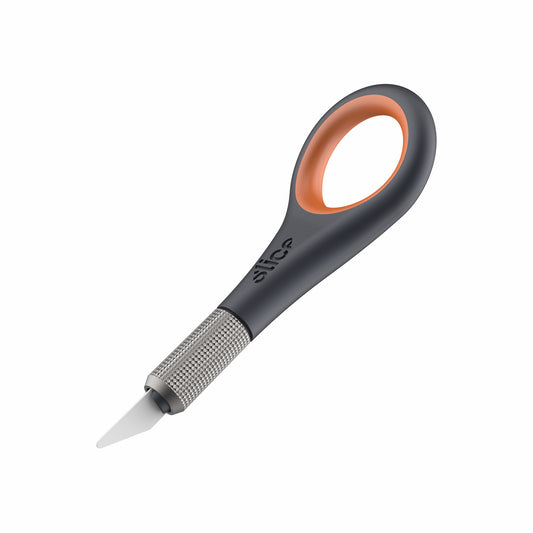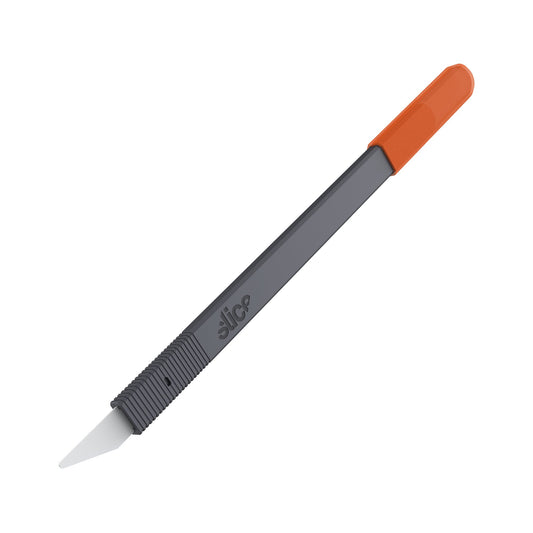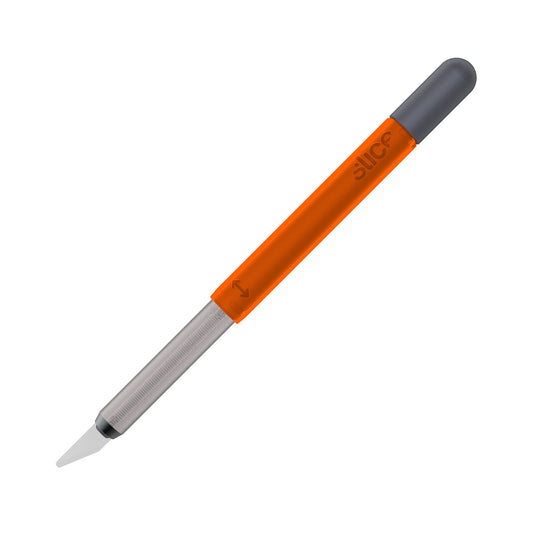Safety Cutting Tools: If It’s Ceramic, It’s Slice

An exploration of safety cutting tools yields a large, and sometimes confusing, variety of features and innovations. From retraction mechanisms to blade materials to specialty applications like an insulation knife, there’s a lot to research if you’re looking to lower costs and reduce injuries, particularly in the large-scale environment of the workplace.
What Is a Safe Cutting Tool?
That sounds like a silly question, but traditionally manufacturers have looked at safe cutting tools in a very narrow way. They have really only looked at one aspect of safety: blade exposure. In other words, how much of the blade is exposed and has the potential to accidentally cut its user? While blade exposure is certainly important, it’s not the only way to mitigate the risks of cutting tools. Here’s why.
The only way to address blade exposure is to redesign the handle. This includes recessing the blade, creating a guard, or adding auto-retraction mechanisms to safety utility knives. These innovations are helpful, but they don’t address some of the basic risks. After all, what cuts you: the handle or the blade?
Below is a breakdown of the risks posed by knives:

As you can see, only 20 percent of the risks associated with knives can be addressed by redesigning the handle. Slice® addresses safety more comprehensively with with the ceramic blades in our safe cutting tools.
How Do Ceramics Change the Game?
Slice uses the same fine ceramics that are popular in kitchen knives. The benefits of this material (100 percent zirconium oxide) include that it’s:
- Non-magnetic
- Non-conductive
- Non-sparking
- Chemically inert
- Rust free
- Safe up to 1600 degrees Celsius
- Non-reactive; impervious to acids and salts
- Oil, lubricant and maintenance free
Slice blades share these characteristics with other fine ceramics knives, but Slice alone has taken advantage of the properties of ceramic blades to create safe cutting tools with a safer blade edge. Our proprietary finger-friendly® grind, combined with the advantages of ceramics, changes the safety game completely.
What Makes Slice The Safety Ceramics Company?
Other knives with advanced ceramic blades are designed primarily for kitchen use. These knives are extremely sharp and cut through food smoothly and without reacting to the acids or fats released by the food. Kitchen ceramics are thin and brittle and can most certainly cut the user as easily as any metal blade.
Slice is the first company to take advantage of the relative hardness of ceramics and reexamine sharpness. We asked, “how sharp does a blade have to be to cut effectively?” As it turns out, the only reason that metal blades are excessively sharp is that they dull very quickly. Their initial sharpness has everything to do with extending their lifespan and nothing to do with creating an effective cutting edge. In contrast, Slice’s edge is only as sharp as it needs to be for effective cutting and includes a smaller cutting zone to protect the user. In addition, this edge stays at a safe, effective sharpness up to 11 times longer than a metal blade.
Safety is the first of Slice’s core values:
Safety: reducing injuries and preventing accidents
Innovation: rethinking safety; fresh perspectives in all we do
Quality: creating quality products and quality relationships
Community: giving one percent for autism research
Simplicity: creating intuitive, easy-to-use products; clear communication with our customers
Because of these values, we re-examine everything from the ground up to create our safety cutting tools’ solutions.

How Do We Make Our Blades?
Slice blades are made from 100 percent zirconium oxide, mined and sifted in Australia. Once the zirconia is purified, it travels to the manufacturing plant where the powder is pressed into basic blade forms and fired at 1400 degrees Celsius to harden. At that point, our blades are ground by hand on diamond wheel grinders to create our proprietary edge. The result is a blade that is thick, durable, and safe to touch. Our blades cut materials effectively but resist cutting skin, and their superior wear resistance allows them to last 11 times longer than steel blades.
Back to Handle Design
Of course, we weren’t satisfied to create a safer blade alone; we also designed our safety cutting tools catalog with a variety of handle choices, both to give options for blade exposure and to create more ergonomic tools. Here are a few of the advances we’ve made.
Micro-ceramic Blades
Slice created this new style of blade specifically for very thin materials like paper, cardstock, and plastic film. The embedded blade, which protrudes about half a millimeter, cuts materials—but not skin—effectively.
Micro-ceramic blades are featured in our:
- 00200 Safety Cutter
- 00116 Precision Cutter (Good Design Award Winner)
Retraction Options
Slice’s retractable safety knife options include the standard auto-retracting handles, as in our 10503 safety box cutter, and our innovative Smart Retract feature, as offered in the 10558 utility knife.
Below are the options in our retractable knives:
- Manual: user chooses one of several fixed positions. Blade stays exposed while cutting.
- Auto-Retractable: User must hold a slider or button to keep blade exposed during cut. Blade retracts automatically when slider is released.
- Smart-Retracting: Blade retracts automatically when it loses contact with the material it’s cutting, even if the user’s finger is still on the slider. This is the safest retraction option of our utility knives.
Fixed (But Replaceable) Blades
Fixed blades, as the name suggests, are used for detailed work where retraction is more of a nuisance than a help. Examples of our fixed blades include our:
- 10548 Craft Knife
- 10589 Craft Knife (Safety Cap)
- 10580 Precision Knife
- 10568 Ceramic Scalpel (Replaceable Blade)
- 10562 Folding Utility Knife
Ergonomic Advances
Ergonomics play a large part in workplace safety and Slice examines the potential for repetitive strain injuries with every tool we design. This was the impetus for the Ergo-Pull™ slider introduced in our 10558 safety utility knife. We discovered that pulling, rather than pushing, the slider button causes less strain on the user. This finding is confirmed by independent third-party testing that compares our 10558 Smart-Retracting Utility Knife with traditional utility knives.
One of our first ergonomic advances was the distinctive J-hook shape of our 10503 and 10400 models—the first in our line of box cutters. These Red Dot Design award-winning tools have handles that wrap around the hand to protect the user, guide the cut, and create a more ergonomic grip angle.
So Where Does Slice Fit in the Safety Cutter Market?
Safety cutting tools distributors sometimes have trouble understanding how to compare our tools to the traditional marketplace options. The truth is that we don’t fit outmoded safety charts because we’re the first company to introduce a safer blade. And in the end, it’s the blade that cuts you. For this reason, we’re comfortable saying (and proud to tell you) that Slice safety cutting tools are an industry game changer.
-
Safety Cutter
Regular price $8.79 USDRegular priceUnit price per -
Precision Knife
Regular price $14.29 USDRegular priceUnit price per -
Craft Knife With Safety Cap
Regular price $20.89 USDRegular priceUnit price per




